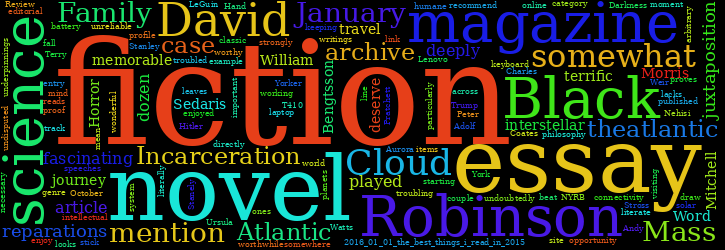
It looks like my beat-up Lenovo T410 laptop is taking the opportunity to fall apart even more this week. It already lacks a working battery and has a somewhat troubled keyboard, but today the Wi-Fi connectivity is starting to become unreliable. Well, it’s what I’ve got, so I’ll do my best with it; but this entry may be a bit late, if I can’t finish it today, January 1st, 2016.
A Few of the Best Non-Books I Read in 2015
First, I want to mention a few non-book items. I read many fine essays in 2015. The best was undoubtedly “The Black Family in the Age of Mass Incarceration,” by Ta-Nehisi Coates, published in the Atlantic magazine in October. You can find the whole thing online. It is very troubling, but very important. I strongly recommend pretty much any of his other work for the Atlantic, especially his essay from 2014, “The Case for Reparations.”
I did not do a good job keeping track of favorite articles I enjoyed from the New York Review of Books or the New Yorker. I will try to do that in 2016. I tried to link to their essay on Trump, but their web site is down at the moment. It was good, but what was really good was the juxtaposition, in the magazine, of their profile directly after a fascinating article about the intellectual underpinnings, philosophy, and world view of Adolf Hitler, based on his writings and speeches. If there is a category for “best editorial juxtaposition of 2015,” that would certainly win. Well played, NYRB, well played!
The Best Books I Read in 2015
Of the books I read in 2015, these are the ones that stick in my mind as particularly good, worthwhile reads. I cut it down to a dozen, which leaves off several worthy books; for example, some good books by Charles Stross, Terry Pratchett, Andy Weir, and Peter Watts didn’t quite make the cut, but that doesn’t mean I didn’t enjoy them. I simply had to draw an arbitrary line somewhere to cut the list of 54 down to a dozen.
- The Left Hand of Darkness by Ursula K. LeGuin. An undisputed classic, this work proves, as if proof was necessary, that genre fiction can be deeply literate and humane.
- Aurora by Kim Stanley Robinson. A science fiction novel about interstellar travel to end all science fiction novels about interstellar travel — literally.
- 2312 by Kim Stanely Robinson. A wonderful journey across the solar system, visiting some of Robinson’s favorite planets, with a couple of memorable companions.
- The Three-Body Problem by Cixin Liu. This is a very strange and fascinating work of science fiction by a Chinese author, newly translated. The sequel is on my to-read pile.
- Hav by Jan Morris. An odd fictional travelogue, it is memorable for its vividly described, imaginative setting, and for the way Morris then allows time, money, and progress to make that marvelous place almost unrecognizable.
- Naked by David Sedaris. I read a number of books by David Sedaris this year, but I want to mention this one in particular. It’s a book of humorous essays, but the best of them are not so much funny as deeply moving. the standout is the absolute gut-punch of an essay, “Ashes.”
- Black Swan Green by David Mitchell. This is a terrific novel and makes me want to read more of Mitchell’s work.
- The Hare with Amber Eyes by Edmund de Waal. This is an amazing non-fiction book about tiny wooden carvings. The story of their journey encompasses the whole arc of twentieth-century anti-semitism in Europe. It’s beautiful, startling, and relevant.
- My Struggle: Book 1 by Karl Ove Knausgaard. Part of a very unsentimental autobiographical novel by a dour Norwegian, its sheer convincing realism makes the sometimes unbearable sadness of everyday reality a thing worth celebrating — because it is real.
- Nature’s End by Whitley Strieber and James Kunetka. I believe this odd, dark, somewhat prophetic potboiler deserves to be back in print.
- The Long Ships by Frans G. Bengtsson. A terrific work of historical fiction that tells an endearingly human story about Vikings. It’s impossible not to like Bengtsson’s characters.
- The Rim of Morning: Two Tales of Cosmic Horror by William Sloane. A reprint of two neglected horror novels, these works really deserve to be remembered along with the work of such writers as H. P. Lovecraft and William Hope Hodgson.
What are you planning to read in 2016?
Saginaw and/or Ann Arbor, Michigan
January 1, 2016

This work by Paul R. Potts is licensed under a Creative Commons Attribution-NonCommercial-ShareAlike 4.0 International License. The CSS framework is stylize.css, Copyright © 2014 by Jack Crawford.
Year Index • All Years Index • Writing Archive


